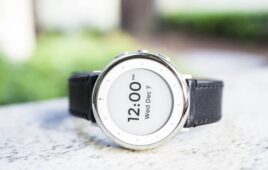
iTTs, made from a liquid-infused material, are optimized devices featuring a novel curved lumen geometry. They enable fast drug delivery into and drainage of fluids out of infected middle ears. Additionally, they prevent bacterial and cell adhesion to their surface. [Image courtesy of Wyss Institute at Harvard University.]
These TTs create an opening between the ear canal and middle ear. Their aim is to ventilate the middle ear, provide a route for fluid to drain out and allow antibiotic drops to reach infection-causing bacteria. However, the researchers say these small, hollow, cylindrical devices made of plastic or metal function “far from perfectly.”
Bacteria may lay down biofilms and local tissue can grow on the surfaces, blocking TTs’ lumen, causing them to extrude. Additionally, antibiotic ear drops may not effectively reach the site of infection. The researchers say these problems also plague other fluid-transporting implantable medical conduits (IMCs). These include catheters, shunts, and various small tubes with use in the brain, liver, eyes, and other organs.
Finding a way to effectively treat ear infections
The multi-disciplinary research collaboration came out of the Wyss Institute for Biologically Inspired Engineering at Harvard University, Harvard John A. Paulson School of Engineering and Applied Sciences (SEAS), and Massachusetts Eye and Ear (MEE) in Boston. They created a complete design overhaul for IMCs with a broadly applicable strategy. The approach enables IMCs with predictable and effective uni- and bi-directional fluid transport at the millimeter scale that resist various contaminations.
Using TTs fabricated from a liquid-infused material — called iTTs — the team co-optimized difficult-to-reconcile functions. These include fast drug delivery into and drainage of fluids out of the middle ear, resistance against water crossing from the outside into the middle ear, as well as the prevention of bacterial and cell adhesion to tubes. The findings are published in the recent cover article of Science Translational Medicine.
“Given our findings, I do see hope on the horizon for patients with chronic ear infections,” said co-senior author and MEE investigator Dr. Aaron Remenschneider. “Not only do our iTTs demonstrate a reduction in cell adhesion and improved selective fluid transport, but we showed how iTTs result in decreased scarring of the eardrum and preserved hearing when compared to standard-of-care control TTs. iTTs could also become an effective tool for delivering a range of drugs to the middle ear.”
Developing the technology
With focus on iTTs as a first application, the team developed a broadly applicable modeling-enabled design process. They can apply this to IMCs with different tasks and locations on the body.
The team based their developments on the physical parameters of liquids, materials and size. They began with the fluid dynamics-based prediction of specific geometries for milimeter-sized IMCs. These IMCs, fabricated with liquid-infused surfaces, control the directional transport of different liquids through them.
“Besides validating the predicted transport of fluids through rationally designed and fabricated iTT prototypes in in vitro models of the middle ear, we also demonstrated their resistance against adhesion by the five most common bacterial strains causing ear infection in children,” said first author Haritosh Patel.
Investigating the technology
To investigate the iTTs’ performance in comparison with traditional TTs in an in vivo model relevant to the human ear, the researchers used chinchillas. This represents the gold standard for studying middle ear diseases and treatments, according to the team. Chinchillas’ tympanic membrane registers around the same size as humans and have a similar frequency range of hearing.
According to the researchers, the ITTs preserved hearing. They also enabled easy and reliable dosing of antibiotic ear drops to the middle ear compared to conventional tubes. Remenschneider noted that this reliability could open the door to new management of middle and inner ear conditions like hearing loss.
“Checking off all essential boxes, iTTs, when implanted into chinchillas’ eardrum, kept out environmental water, prevented infectious buildup, reduced scarring, and remained clear for aeration and pressure equalization,” said Patel.
The researchers say their safety and efficacy results could lead to testing in human patients in a clinical trial. They also look forward to extending the patented design approach to other IMCs. According to co-senior author Joanna Aizenberg, they could create personalized devices optimized for specific patient characteristics and needs.
“We envision that iTTs’ and other IMCs’ material and geometrical properties in the future could be reverse-engineered to adapt them to different drug formulations and make them a part of the drug discovery process for an efficient topical delivery of therapeutics and treatment of various diseases,” Aizenberg said.




